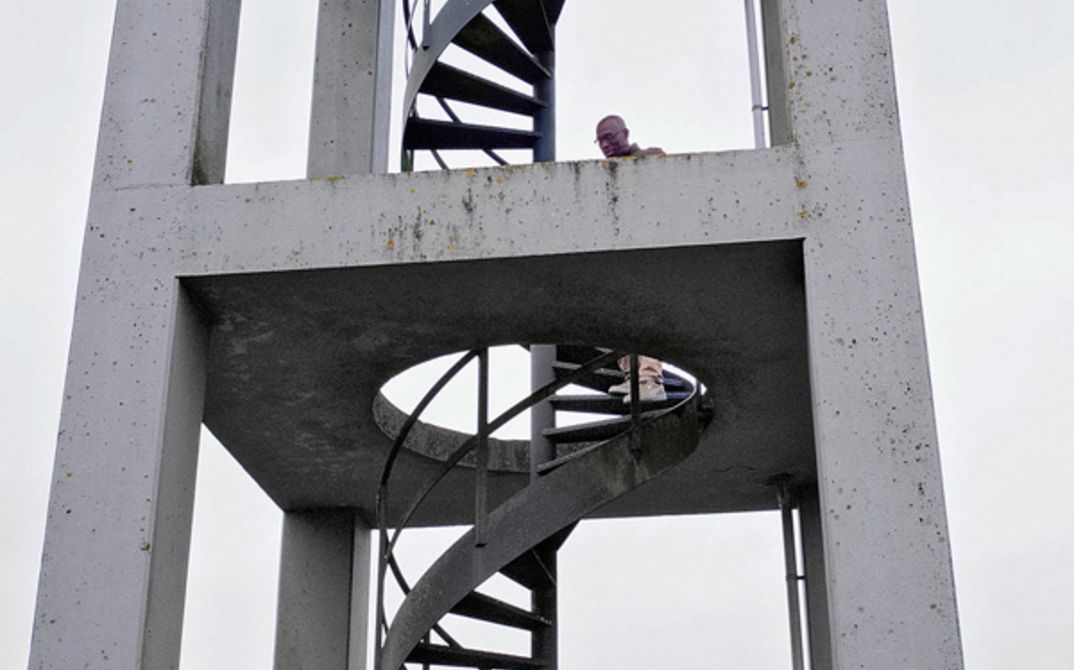Cinema Diaspora
At a moment when neonationalist and neofascist tendencies seek to forge a re-homogenized white nation, CINEMA OLANDA FILM not only represents a different kind of collective subject but also actively seeks to constitute it. Here the film shoots are crucial. The spatial and social configurations created by Wendelien van Oldenborgh are not that bogeyman of the alt-right, the “safe space” populated by namby-pamby privileged students unwilling to face the challenges of real life (such as racism and sexism, presumably). While they’re blissfully free of alt-right trolls, they’re not homogeneous. These are impure spaces in which processes of (trans)subjectivation can take place. The locations bring their own histories to the table. The setting for the film CINEMA OLANDA FILM is provided by architect Harry Nefkens’s modernist Saint Bavo Church in Pendrecht, the postwar neighborhood in Rotterdam planned by Lotte Stam-Beese, which is such a location. That the leftist architect Stam-Beese gave a prominent place to a Catholic church in her modernist extension of Rotterdam is part of the historic compromise of the “wederopbouw” (reconstruction) years, in which the religious (Protestant and Catholic) “zuilen” (columns or pillars) enjoyed a last hurrah before entering into decline in the 1960s. Many of the postwar modernist churches across Holland have now been demolished or repurposed. That Saint Bavo still functions as a church is also due to immigrants, including immigrants from the (former) Dutch colonies in the Caribbean. In 2003 banlieu-type problems with young migrants in Pendrecht occasioned a debate in Rotterdam about a “spreidingsbeleid voor kansarme allochtonen”—a “distribution policy for disadvantaged migrants” to prevent “ghettoization.”* In a bizarre historical return, spreidingsbeleid is the exact same term that was used in Amsterdam in the late 1970s to scatter the Surinamese immigrants across the city and across hostels.
CINEMA OLANDA FILM deals with historical events and the historical figures of Lotte Stam-Beese and Otto Huiswoud, the latter being a Surinam-born, New York-based communist with many contacts in the arts, especially poetry; like Stam-Beese, he spent time in the Soviet Union in the early 1930s. The film consists of a single sequence shot that goes from a gliding crane movement to a bumpier hand-held-camera that moves from the square in front of the church inside. The camera moves from timelines being read out past conversations and scuffles, past young guitarists playing “Indo rock” (a Dutch postwar movement created by immigrants from former Dutch East India/Indonesia), more spoken exchanges, a reading of Langston Hughes’s poem “Democracy,” and a final performance by a young band. Among the readers and speakers are the publicist Lizzy van Leeuwen, the artist Patricia Kaersenhout, and Mitchell Esajas of the New Urban Collective, which houses part of Otto and Hermina Huiswoud’s papers. Archival documents such as old copies of “The Negro Worker” or a copy of Roy De Carava and Langston Hughes’s photo essay “The Sweet Flypaper of Life,” dedicated by Hughes to Hermine Huiswoud, inform the conversation.
As in previous works such as MAURITS SCRIPT, CINEMA OLANDA FILM is marked by a dialectic of reading out written documents and having conversations that are shaped by them. In PROLOGUE: SQUAT / ANTI-SQUAT,** which focuses on the more recent past and on living memory, informal conversation is more dominant. While many of Van Oldenborgh’s works—including CINEMA OLANDA FILM —contain scenes with people reading from published texts or archival documents, the prologue shows Roel Griffioen and Khadija al Mourabit reading books titled “De stad is van ons” (a manifesto by the Belgian-Lebanese activist Dyab Abou Jahjah) and “The City is Ours” (a multi-author volume on squatting). However, they discuss their content rather than declaiming from them.
Modern emancipatory projects were enabled by print. That goes for Marxism as well as for anti-colonial movements—and of course many protagonists of anti-colonialism embraced Marxism, including Otto Huiswoud. For Huiswoud, the formative experience was not that of industrial production in the heartlands of capitalism, but of colonial exploitation.*** While the original impetus comes from the daily and visceral experience of exploitation and oppression, patient study— reading and discussion—is required to make sense of this experience and develop a critical and active stance. In an age in which the manufacturing of neo-illiteracy is one biopolitical tool among others, it is tempting to wax nostalgically about a lost print culture. Van Oldenborgh’s work takes a less melancholic position, incorporating the written and the printed word in a post-Gutenbergian acoustic and social space, in which texts are excerpted, quoted, de- and recontextualized, and debated.
(Sven Lütticken: “Cinema Diaspora,” in: Lucy Cotter (ed.): Wendelien van Oldenborgh, Berlin 2017, pp.102–104.)
*In these debates, Pendrecht was often used as an example of the kind of inner-city hell that a “spreidingsbeleid” would serve to prevent: see www.mario-bosch.nl/pendrecht-vitaal.htm.
**Also part of the installation “Cinema Olanda” in the Dutch pavilion of the 57th Venice Biennale 2017.
***See Régis Debray, “Socialism: A Life-Cycle,” in New Left Review (July-August 2007), pp. 5–28
